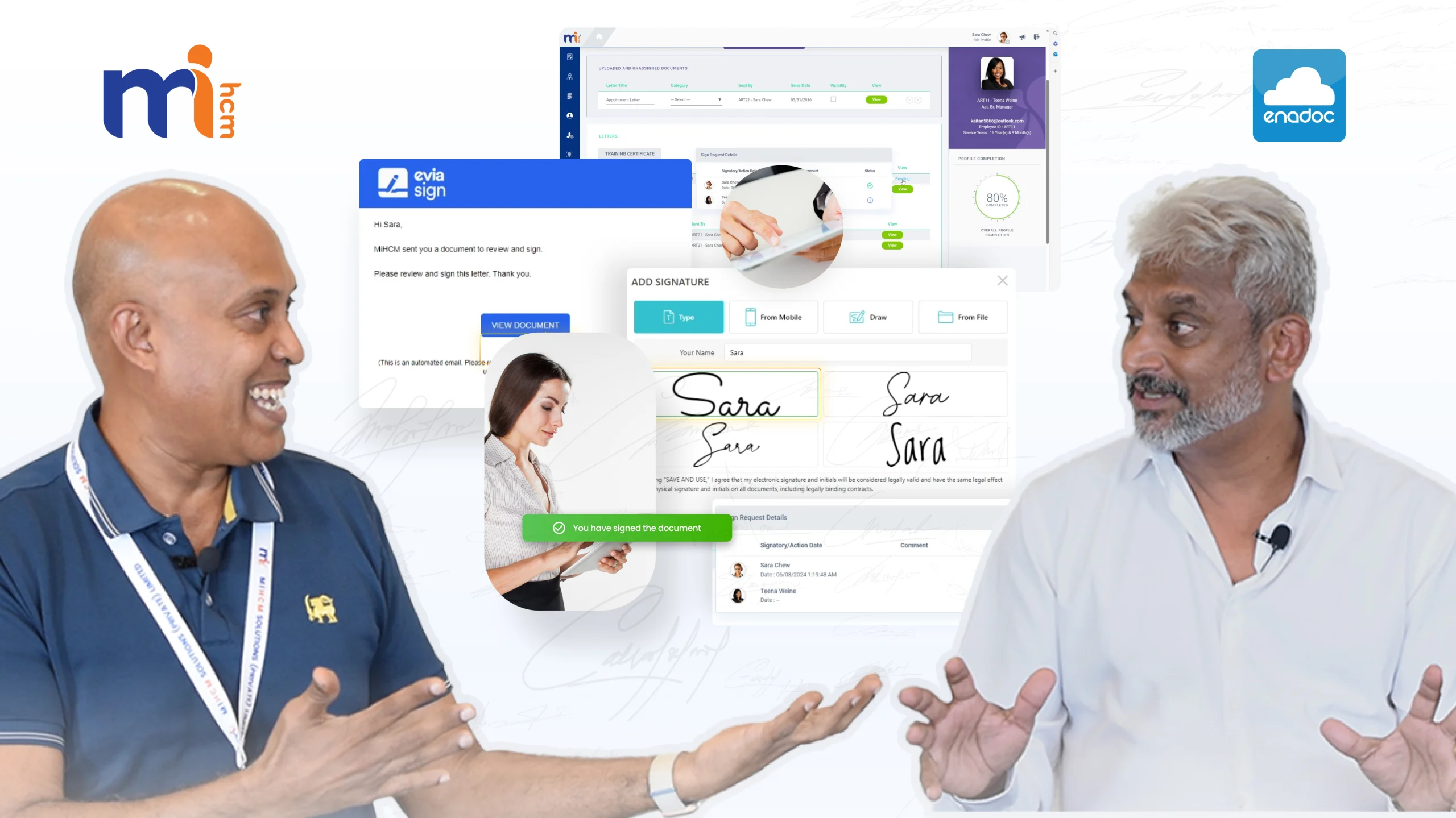
With the globalisation of the workforce and more companies shifting to digital workspaces, digital signatures – or e-signatures – are at the forefront among solutions being adopted by HR departments.
With e-signing streamlining document workflows by offering a frictionless way to validate paperwork and providing a much-needed edge in today’s digital age, MiHCM wanted to offer its customers an e-signing solution that ensured compliance, convenience, and security.
While looking around for a secure and efficient software that would seamlessly integrate with the MiHCM cloud-based HR platform, MiHCM Founder/CEO Harsha Purasinghe got to talking with Enadoc Co-founder/Chief Technology Officer Wasantha Weerakoone, who showed him the demo for Enadoc’s Evia Sign digital signature solution.
That conversation led to both teams building a compelling, seamless integration and today the Evia Sign solution is offered to MiHCM’s international clientele via a quick and easy sign-up process.
Here, Harsha and Wasantha explain the how, what, and why of e-signatures and Evia Sign – covering core capabilities, security and legal aspects, and more.
How it all began
Question: What was the initial vision behind Evia Sign? What brought it about and what was the end goal?
Wasantha: A lot of innovations that happened in the past happened as a necessary evil to solve a problem. With the Evia Sign solution, we did not invent anything in terms of digital signatures, but we reinvented their use during the pandemic.
During the pandemic, we had big challenges internally as an organisation. We have operations in eight different countries and our C level sits in different countries, so we were forced to invent or innovate something very quickly to address the challenges we had at that time in terms of being able to get approvals and sign documents, because work never stopped, even though the pandemic made us all stay in one place.
That product quickly developed into an independent product. While it was part of our Enadoc portfolio, we took it out and made it a standalone product that could help organisations quickly and easily do approvals and digital signing.
Why MiHCM selected Evia Sign

Question: Coming to HR and MiHCM, Harsha, at which point did you realise that it was essential to bring in an e-signing solution and why did you decide to go with Enadoc’s Evia Sign solution?
Harsha: As you know, MiHCM is a digital HR platform which came to the market in 2017. At the inception itself, I wanted to see our letter builder component completely integrated with a digital signing platform. But that’s not how software works; it’s an evolutionary process. In this whole process, we realised it was way too early at that time to bring in digital signing right away.
However, during the pandemic, we started exploring some of the tier 1 digital signing products. In fact, with one tier one product, we almost did the entire integration, and we were going to make the announcement, but we put it on hold because of the long-term strategy that we wanted to have. We wanted to bring in digital signing capability for all our users, not only for certain Enterprise customers who could afford it.
When we were at that juncture, I met Wasantha by chance one day when I was travelling in Southeast Asia. We had a casual discussion, and he showed me this new e-signing product. When I saw the demo, it was a no-brainer for me to explore this further, due to several reasons.
For starters, Tech One Global has been one of MiHCM’s partners for over five years and Enadoc is a fully owned subsidiary of Tech One. We already had a working relationship with Tech One, so it was a no-brainer to work with them, while Wasantha is someone I have known for almost two decades, so I was so happy to get this going. We put our teams together to build a very compelling, seamless immigration, where both teams did a remarkable job.
But let me tell you why we wanted to enable this kind of digital signing capability for a product like MiHCM. It’s all about bringing in efficiency and productivity to HR and giving a different experience, whereby you eliminate the requirement of printing, signing, scanning, and mailing documents. You don’t need to do all that anymore with a digital signing solution.
Next, it’s about the automated workflow capabilities that digital signing systems offer – a fantastic workflow capability where ultimately the document is securely stored digitally with complete audit trails. It has full security and compliance, you eliminate the printing costs, and it is tamper proof.
It’s also about your professional image as an employer. When you dispatch an electronic signature-enabled document to a prospective candidate, it gives another level of image building to people planning to join your organisation. All of this meant that it was a no-brainer for us to include a digital signing capability on the MiHCM platform.
Evia Sign’s core capabilities
Question: Harsha, you touched on a few important aspects of how e-signing can really empower HR on a system like MiHCM. Following up on that, Wasantha, could you go a little deeper into the core capabilities of Evia Sign and how you benchmark yourself against other global products?
Wasantha: Digital signing, as I mentioned before, is not something that was invented by us. It has been around for decades. But the biggest problems in digital signing platforms were in terms of their usability, user friendliness, and capabilities that help them integrate with other existing solutions.
When we started developing the solution, our key parameter was user experience in a multitude of directions – user experience as an actual person signing the document and user experience in terms of someone who wants to integrate their product.
Digital signing or sealing is the last mile of any process where you finalise the document by signing or sealing it. Before that stage, there are multiple platforms or solutions that should be able to easily integrate. Flexibility is a core capability of our application, which offers multiple integration capabilities.
In terms of user friendliness, we have the advantage as we are very new to the industry, so we use the latest technologies, unlike some competitors who have been there for 20-30 years, whose legacy code does not help them to be creative. I think that’s an advantage that we and MiHCM have.
When we started this, we were able to use the latest and greatest tools to create the solution, which gave us an opportunity to offer a great user experience. User experience is becoming far more important today than anything else. Harsha and I are fanatic about driving the user experience; that’s our specialty. I don’t like to talk about the competition as our product speaks for itself.
How Evia Sign works on MiHCM

Question: It’s exciting how e-signing can improve usability and boost the digital transformation of a company. Harsha, can you tell us about how this really works on MiHCM and how it can empower both HR and employees across organisations that use MiHCM?
Harsha: The process to enable Evia Sign on MiHCM is simple. Any customer who wishes to enable it can subscribe to the Evia Sign service on MiHCM. Once we provision the subscription, the admin user of the customer tenant can log in and set up an Evia Sign adaptor as the first step. It’s a seamlessly integrated process; you go to the Evia Sign adaptor page and sign into Evia Sign, that’s it. It’s established as a seamless integration between Evia Sign and MiHCM.
Once that is done, MiHCM HR users and admin users can go to our template builder and design the letter template for which they want to integrate digital signing – it could be letters related to contracts, appointments, offers, transfers, promotions, or any kind of HR-related letters.
What you will notice apart from our standard tags will be the seamlessly integrated Evia Sign tags, which you can drag and drop into the letter template of your choice. You can put even the date and time stamp and save the template. That’s it. Then you can send the letter either to one or multiple employees and it will go through the workflow and the respective signing authorities will digitally sign the document. When the final person signs, it will simply store the document with the signing history in the MiHCM employee profile document repository.
It’s not just that. The user who originates the process can see the audit trail of the entire signing process and where the document is stuck at any given point. That’s one of the use cases.
The other interesting use case is regarding offer letters, which are seamlessly integrated into our recruitment process. When you send a final offer letter, once the potential candidate signs it, you can immediately see the sign-off time. It is signed in our recruitment module itself. This is how we have seamlessly facilitated the digital signing process with Evia Sign in MiHCM.
Feedback from MiHCM customers
Question: MiHCM introduced this to its client base a few months ago. What can you tell us about the initial reaction from clients?
Harsha: Well, the response has been phenomenal. We had a fantastic event at the Shangri-La in Colombo and a follow-up event at our Headquarters in Kuala Lumpur recently to announce this. We have been getting very good feedback, especially from our existing customers, for enabling digital signing, which was a missing piece in our digital HR platform, seamlessly. Now it’s facilitated as a very competitively priced offering. That’s another key reason for integrating Evia Sign.
So, first things first, before we introduced it to customers, we enabled it in our own company. Once we realised its potential for ourselves, we went outside and became advocates to our customer base.
It’s just a matter of time before we see many existing users signing up and enabling this feature. Forums like this will enable existing and potential users to see the powerful capability of two companies working together to bring in a seamless, secure, and compliant solution for HR document processing.
Legal implications of e-signatures
Question: Wasantha, some people may have concerns about the potential legal implications of using an e-signature solution like Evia Sign. Can you tell us about the measures you’ve taken as a company to ensure compliance and security of these documents and the legal implications of e-signing in general?
Wasantha: This is a great question and one that is frequently asked when it comes to digital signing and sealing. I need to break it into three components.
The first is legality. Legality is based on jurisdiction. Different countries have adopted digital signatures as a means of sealing documents. If you look at Asia, most of the countries have accepted this. In Europe and the US, of course, digital signing has been there for a long time. If you’re looking at the legal framework, most of these countries have adopted digital signatures as a tool for sealing documents. That’s the first part of it.
The second part is, how can you make digital signatures secure? The security aspect of digital signature has two components. One is how secure your system is and the second is how you get your documents securely signed.
To answer the first, there are a multitude of standards that check whether your tool or toolkit is compliant in terms of certain standards, such as ISO 270001 and ISO 9001:2008, Standard Operating Procedure (SOP) compliance, and eIDAS (electronic identification, authentication, and trust services). There are many different types of standards, and we follow and support most of them, ensuring that our platform is secure.
Last but not the least is how you request a secure signature – how you make sure that the one who is signing is the person who is supposed to be signing. For that, we have brought in multiple technologies. You can have email- or SMS-based OTPs enabled and a one-time passcode where you can do user verification. We are also adding facial recognition and liveliness check, which will be released very soon. All your customers will enjoy that feature soon.
Usability and security within MiHCM

Question: Thank you for the sneak peek into things to come, thanks to which any MiHCM customer can rest assured that they are in safe hands with Evia Sign and MiHCM. Harsha, could you tell us about the usability and security aspects within MiHCM? When integrating Evia Sign, how can we ensure that companies can maintain and sign documents with trust and confidence in this system?
Harsha: I think Wasantha already partially answered that question by giving a solid assurance, especially in terms of the additional aspects they are bringing in, especially multi-factor authentication to ascertain the true identity of the signing authority. That’s a very important aspect that Wasantha touched on, because they are even bringing in biometric capability.
When it comes to security and compliance, Evia Sign has eIDAS compliance and Wasantha just listed the OTP capabilities over SMS and email, digital certificates, ISO 27001, you name it – in terms of security, it’s a solid assurance.
Another important aspect is, of course, usability. That’s where we brought in lots of interesting capability where we integrated this beautifully to all the interesting touchpoints in our entire document workflow chain. You can now securely sign documents anytime, anywhere, on any device. People can be all over the world; they get an email notification on a mobile device, click, go to the authenticator, enter, and sign digitally.
When it comes to signing itself, there’s a multitude of options as well. You can use a signing device like a stylus or your finger or you can scan an image. There are many options enabled in the Evia Sign platform. We have really thought through this whole experience. It’s very important to give a solid digital experience to employees as well as HR users when integrating while maintaining the most important elements of compliance and trust.
Prioritising sustainability
Question: Thank you, Harsha. We’ve discussed so many different things, from the security aspect to the technological impact. One final area is sustainability. From a sustainability standpoint, Wasantha, what can you tell us about the importance of committing to using e-signatures?
Wasantha: Sustainability has become something that people always talk about, but many people don’t act on it. I am very happy to say that MiHCM has integrated e-signatures, which is one of the topmost priorities in terms of sustainability.
Imagine how many trees we cut every day for paper. Integrating the whole ‘cradle to the grave’ process electronically adds not only security but also efficiency while saving the environment for our children.
The amount of paper you are saving in the whole process is enormous. HR is one of highest paper consuming places in any office. Electronically driving the whole process offers a lot of savings not only in terms of money, but also in terms of carbon footprint and various other aspects. I congratulate MiHCM for not just talking about sustainability but doing it.
Learn about more about the Evia Sign digital signature solution on MiHCM here


